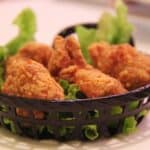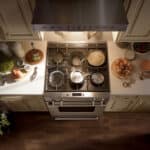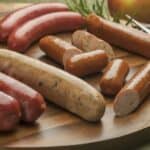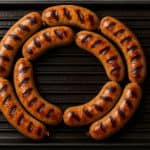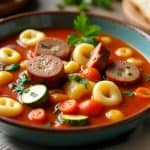According to home improvement expert John, “Range hoods can drip oil when grease builds up and isn’t properly cleaned.
Over time, enough grease accumulates to start dripping down.”
If you notice oil dripping from your range hood, it likely means there is a grease buildup inside the hood or ductwork that needs cleaning.
This can become a fire hazard if left unchecked.
The best way to prevent drips is regular cleaning of the baffle filters and ducts.
Keep reading to learn what causes grease buildup in range hoods, how to clean it, and tips to stop future drips.
With some simple maintenance, you can stop annoying oil drips and keep your kitchen safe.
KEY TAKEAWAY
Why does my range hood drip oil?
Oil dripping from your range hood (1) can be caused by factors like grease buildup, fan speed, and maintenance issues.
Addressing these factors can help you prevent and solve this common kitchen problem.
Common Causes of Range Hood Oil Dripping
Seeing greasy drips coming from your range hood can be worrying.
But it actually happens pretty often.
Here are some typical reasons range hoods end up dripping oil:
One big cause is leftover gunk from cooking.
Frying or sautéing sends tiny grease specks into the air.
They get sucked into the hood then stick to the sides, vents, baffles and fan.
After a while, enough sticky buildup forms to start slowly dripping oil.
Another issue is grime in the ductwork.
If range hood pipes and vents don’t get scrubbed regularly, grease coats the insides over time.
When new hot air and steam pass through, it loosens up the old gunk, pushing drips out near vents or outside.
Clogged filters are a common culprit too.
Grease gets trapped in the mesh to keep it out of ducts.
But if filters get too filthy, grease slips through into the system.
Be sure to check and wash filters each month in hot water.
Using too low of a speed when cooking is another problem.
High heat from broiling or frying needs strong suction to capture all the tiny oil molecules floating around.
Make sure to use the high setting when searing or cooking greasy dishes.
So in summary, cooking grease, dirty ductwork, blocked filters and weak fan speeds let gunk slowly build up until it starts dripping from warm range hoods.
But keeping things clean and using the right settings prevents messy drips!
Understanding the Role of Aluminum Filters
Aluminum mesh filters (2) play an important role in blocking oily drips.
Here’s how they work and why cleaning them regularly matters:
The angled honeycomb pattern forces airflow to spin inside the filter.
This centrifugal force makes oil particles stick to the metal surface while air keeps flowing.
Over time, grease slowly builds up on the mesh filter.
If it’s not washed away, airflow becomes restricted, allowing some oil to pass through into ducts.
Washing filters monthly in hot sudsy water removes all that sticky gunk.
Avoid aggressive scrubbing which can damage the delicate mesh.
Air drying prevents water spots.
Some models have dishwasher safe filters for easy cleaning.
Replace filters every 3-6 months depending on usage to ensure good airflow and trapping.
Mark install dates with a permanent marker as a handy reminder.
Ventless range hoods use special charcoal filters instead to absorb smells and smoke.
But they don’t catch grease like aluminum mesh types.
By regularly maintaining aluminum filters, range hoods run smoothly and keep ducts grease-free.
So be diligent about monthly washings and replacements – it really makes a difference!
Cups and Traps: Preventing Oil Leaks

Small oil leaks from a range hood can create big messes over time.
Using grease cups or traps helps catch drips before they become a problem.
Here’s how they work:
Grease cups attach below the hood right where drips tend to form.
The cup catches oil so it doesn’t splatter on stoves or counters.
Just empty and wash cups periodically as needed.
For ducted hoods, installing a grease trap in the vertical duct run also helps.
Grease gets caught in the removable metal box rather than dripping outside.
Traps should be cleaned every 2-3 months.
Cups and traps contain and conveniently collect oil so it doesn’t create safety hazards or cleaning headaches.
They protect walls, furniture and appliances from stains too.
I added inexpensive cup and trap accessories to my own hood setup.
After frying up chicken and bacon for dinner most nights, I would find small puddles of grease on my stove.
The drips made cleanup a real chore.
But now my trusty grease catcher contains it all!
With the right containment tools, range hoods run cleanly for years without leaks or clogs.
Protect your cooking space and simplify cleaning with handy cups and traps installed nearby drip-prone areas.
Cleaning and Maintaining Your Range Hood
To prevent range hood oil leaks, regular cleaning and maintenance are a must.
Here are some best practices:
- Wash metal filters monthly in hot soapy water to remove built-up grease. Avoid abrasive scrubbing to prevent filter damage.
- Clean fan blades, ducts and vents every 3-6 months using degreaser and pipe cleaners for hard to reach areas. This prevents oil buildup.
- Replace charcoal filters every 6-12 months per manufacturer recommendations to maintain odor absorbing performance.
- Check for leaks monthly and tighten any loose screws or connections as needed to prevent drips.
- Use high fan speeds when cooking greasy foods to properly vent all oil molecules and residue.
- Wipe down stainless steel surfaces frequently using cleaning wipes suitable for stainless steel to prevent grease buildup.
- Schedule professional hood cleaning annually since some residue may be challenging to remove yourself.
With regular filter washings, comprehensive cleanings, and leak checks, your range hood will run like new for years while keeping your kitchen grease-free.
Don’t wait until you see oil drips – proper maintenance prevents problems!
Preventing Oil Drips from Your Extractor Fan

If you’re like most people, you probably don’t give much thought to your kitchen exhaust fan until it starts dripping oil.
But did you know that this problem can be easily prevented with a few simple steps? One of the most important things you can do is to clean the filters regularly.
Over time, grease and oil can build up on the filters, causing them to become clogged and less effective.
This can lead to leaks and drips from the fan.
By cleaning the filters on a regular basis, you can prevent this from happening.
Another important step is to check the cups and traps inside the hood.
These are designed to catch any grease or oil that may escape the filters.
If they become full, they can overflow and cause drips from the fan.
By checking and emptying these cups and traps regularly, you can prevent this from happening.
It’s also important to use the right type of filter.
Aluminum filters are the most common type, but they can be less effective at trapping grease and oil than other types of filters.
If you’re experiencing problems with leaking grease, you may want to consider switching to a different type of filter, such as a baffle filter or a charcoal filter.
Optimizing Fan Speed to Stop Oil Dripping
In addition to cleaning the filters and checking the cups and traps, optimizing the fan speed can also help prevent oil drips from your extractor fan.
When the fan is running too fast, it can create a vacuum effect that pulls grease and oil through the filters and into the fan.
By adjusting the fan speed to a lower setting, you can reduce the amount of air flowing through the hood and prevent this from happening.
It’s also important to note that using hot water can help to break down grease and oil, making it easier to clean.
When cleaning the filters and cups and traps, be sure to use hot water and a degreaser to get rid of any buildup.
Finally, it’s important to remember that prevention is key.
By taking these simple steps to prevent grease and oil buildup in your extractor fan,
You can avoid the hassle and expense of dealing with leaks and drips in the future.
So take a few minutes to clean your filters, check your cups and traps, and adjust your fan speed,
And you’ll be well on your way to a cleaner, more efficient kitchen exhaust system.
Root Causes: Why Does Your Hood Drip Oil?
Hood leaking can be caused by a variety of factors, including grease buildup, malfunctioning cups and traps, and poor air quality in your kitchen.
Grease buildup is one of the most common causes of hood leaking.
Over time, cooking oil and grease can accumulate on the hood and filters, causing them to become clogged and less effective.
This can lead to leaks and drips from the hood.
Malfunctioning cups and traps can also contribute to hood leaking.
These are designed to catch any grease or oil that may escape the filters, but if they become full or clogged, they can overflow and cause leaks.
Regular cleaning and maintenance of these cups and traps is essential to prevent this from happening.
Poor air quality in your kitchen can also contribute to hood leaking.
If your kitchen is poorly ventilated, or if you’re using a lot of oil and grease in your cooking, this can lead to a buildup of moisture and condensation on the hood and filters.
This can cause leaks and drips, as well as other problems like mold and mildew.
It’s important to address these root causes of hood leaking to prevent further damage and ensure that your kitchen is a safe and healthy place to cook and eat.
By cleaning your hood and filters regularly, checking and maintaining your cups and traps, and improving the ventilation in your kitchen, you can help prevent hood leaking and other problems.
Maintenance Schedule for Cups and Traps

To prevent hood leaking and other problems, it’s important to establish a regular cleaning and maintenance schedule for your cups and traps.
This should include emptying and cleaning the cups and traps on a regular basis, as well as checking for any signs of damage or wear.
A good rule of thumb is to clean your cups and traps at least once a month, or more frequently if you do a lot of cooking with oil and grease.
You should also check them for damage or wear every time you clean them, and replace them if necessary.
In addition to regular cleaning and maintenance of your cups and traps, it’s also important to clean your hood and filters on a regular basis.
This can help prevent grease buildup and other problems that can lead to hood leaking.
Be sure to follow the manufacturer’s instructions for cleaning your hood and filters, and use a degreaser to help break down any stubborn grease and oil.
By establishing a regular cleaning and maintenance schedule for your cups and traps, as well as your hood and filters,
You can help prevent hood leaking and other problems, and ensure that your kitchen is a safe and healthy place to cook and eat.
Frequently Asked Questions
Why does my range hood drip oil even when not in use?
Oil and grease can slowly leak out over time.
If grease has built up, it can start dripping down even when you aren’t actively cooking or using the hood.
Regular cleaning is essential to prevent this.
I cleaned my range hood and it still drips – what should I check?
The issue may be in the ductwork if your range hood was thoroughly cleaned but still drips.
Built up grease in the ducts can start slowly dripping out onto the hood.
Inspect and clean the ductwork.
How do I clean grease off my kitchen walls or cabinets from range hood drips?
Use a degreasing spray and let it soak for several minutes.
Then wipe down with hot water and detergent.
You may need to repeat and scrub for tough grease stains.
Prevent future drips with regular hood cleanings.
What causes grease to build up in my range hood ductwork?
The hot air and vapor from cooking carries tiny grease particles into the ducts where they cool and condense on the sides of the metal ducts.
Over time, thick sticky grease coats the insides.
I have a new high-CFM range hood but it still drips – why?
High airflow helps capture cooking fumes but doesn’t prevent grease accumulation on the baffle filters, fan housing, etc.
Powerful range hoods still need regular cleaning to prevent drips.
Can I line my range hood with aluminum foil to catch drips?
No, you should never line any part of a range hood with aluminum foil.
This is a fire hazard.
It can also clog airflow.
Regular cleaning is the safest approach.
Conclusion
Regular cleaning is crucial to stop range hoods from dripping oil.
Over time, grease accumulates on the baffle filters, fan blades, interior surfaces, and ductwork. This grease buildup eventually starts dripping back down – even between uses of your hood.
To prevent annoying oil drips, deep clean your range hood every 3-6 months.
Soak the baffle filters in a degreaser. Use a wire brush to scrub stuck-on gunk.
Clean fan blades and the housing with hot water and detergent.
Also inspect the ductwork behind your range hood.
Built up grease here can slowly start dripping out. Carefully clean the ducts to remove residue.
Consider hiring an HVAC professional if you can’t easily access the ducts.
With consistent thorough cleanings, you can stop those annoying oil drips and keep your kitchen safe.
But neglecting maintenance will allow the issue to continue.
Set reminders to regularly clean your range hood. This small effort will prevent headaches later.
Let me know in the comments if you have any other questions!
References
- https://master-tech.com.au/top-4-reasons-why-your-rangehood-becomes-too-greasy-and-drips-oil/#:~:text=Range%20hoods%20need%20to%20be,filter%20which%20causes%20the%20dripping.&text=Grease%20deposits%20in%20the%20grease,greasy%20and%20is%20dripping%20oil.
- https://www.guardiandallas.com/blog/kitchen-hood-filters-everything-you-need-to-know/
Related Articles
- https://milkwoodrestaurant.com/how-to-clean-electric-range-burners/
- https://milkwoodrestaurant.com/best-oven-cleaner-for-baked-on-grease/
- https://milkwoodrestaurant.com/clean-oil-spill-in-oven-ways/
- https://milkwoodrestaurant.com/pacific-range-hoods-reviews/
Was this helpful?

I’m Mary R. Q. , a seasoned professional chef dedicated to elevating home cooking experiences. Through my expertise in the culinary arts, I provide practical cooking tips and insightful reviews of kitchen utensils on my blog, milkwoodrestaurant.com. As a passionate advocate for transforming everyday meals into extraordinary culinary adventures, I aim to empower home cooks with the knowledge and tools they need to create delicious and memorable dishes. I’m also an author of the book “1,001 Kitchen Tips & Tricks: Helpful Hints for Cooking, Baking, and Cleaning (1,001 Tips & Tricks)” which is sold on Amazon. Join me on a flavorful journey as we explore the art of cooking and the essential tools that make it a joy.



